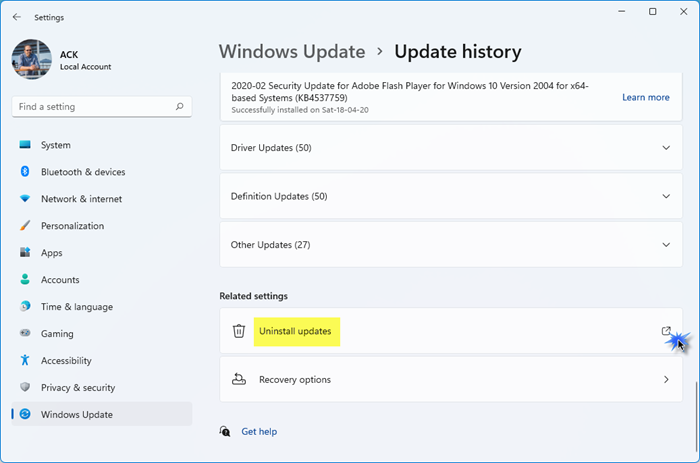If you find yourself in one of these situations while dealing with Windows Updates, then try some of the solutions provided here. These are some of the most common solutions to the most common problems. In some cases, you may have to enter the Safe Mode to be able to carry out the suggestions. Updates are meant to enhance the security of your computer; it’s best not to remove an update unless you’re certain that it is causing a problem. Take these steps to be certain you want to remove an update:
How to Uninstall Windows Updates in Windows 11
To Uninstall Windows Updates in Windows 11, do the following:
Uninstall Windows Updates in Windows 10
To remove a particular update in Windows 10 do the following: Open Settings > Update and Security > Windows Update > View update history and then click on Uninstall Updates.
This will open a window that will show the list of all the installed updates on your computer. Then you can select the update you want to uninstall and click on the Uninstall button on the lower right corner of the window. It is important to mention that if you have used the Disk Cleanup Tool to delete the Windows Update Cleanup option, then you might not be able to uninstall the Update. In Windows 7, click Start and then click All Programs and select Windows Update from the list of programs. In Windows 8, open the WinX menu and click open Control Panel. Now open the Windows Update applet. From the View update history, select the update that you want to remove, and note down its KB number. I suggest you go here first as it offers some description too. Now open the Program and Features applet of the Control Panel, and from the left side click on View Installed Updates. Right-click on the Update you wish to uninstall and click on Uninstall. The update will get installed. You may be required to reboot your computer.
Remove Windows Updates using the command line
Run the following command to see the Windows Update History: To uninstall Windows Updates using the command line, open an elevated command prompt window, type the following, and hit Enter: Here 1234567 should be the number of the Update you wish to uninstall. Here we are using the built-in WUSA or Windows Update Standalone Installer tool.
Uninstall Windows Updates via Advanced Startup Options screen
You can also uninstall Windows Updates via the Advanced Startup Options screen in Windows 11 or Windows 10. Open the Advanced Startup Options screen > Troubleshoot > Advanced options > Uninstall Updates.
Read: Show or Hide Updates Tool will block unwanted Windows Updates.
Windows Update General Troubleshooting Tips
1. A recently installed update is causing the problem:
If you are sure enough that a recently installed update is causing the problem then only try these steps or before uninstalling it try to find information about any problems that have occurred on the computer by checking for a solution. If no solutions are available, check the Windows Update history to learn more about recently installed updates.
Click Start and then click All Programs and select Windows Update from the list of programs.In the left pane, click View update history.To view more information about an update, double-click it.
2. You are not able to remove an update:
You may face this error because you might be connected to a network where updates are managed by Group Policy. These network-wide settings can prevent you from removing an update. In other cases, you might not be able to remove an update because it applies to a security-related area of the operating system. If you think an update that you can’t remove is causing problems, contact the system administrator of your organization.
3. A removed update is getting reinstalled automatically:
Your computer is probably connected to a network where Group Policy settings determine which updates must be installed on each computer. These network-wide settings can reinstall any required updates that you’ve removed. You might also have Windows set to automatically install updates, which is the recommended setting for your computer. If you don’t want Windows to install an update, you need to hide it.
Click Start and then click All Programs and select Windows Update from the list of programs.In the left pane, click Check for updates.When Windows finds updates for your computer, do one of the following:Click on important updates links if you have important updates to hide.Click on optional updates links if you have optional updates to hide.Right-click the update you don’t want to install, and then click Hide update. The next time you check for updates, the update won’t be automatically selected or installed.
The same steps are also applied if you want to stops Windows Updates from offering an update that you don’t want to install like Language packs.
4. Your Device or Hardware is not working after updating its device drivers from Windows Update:
You might need to revert to a previous version of the driver for that device. Check the manufacturer’s website for a more recent version of the driver, or remove the driver and restart your computer.
5. No Uninstall option?
This post shows how to uninstall Windows Updates marked as Permanent without Uninstall option.
6. Cannot boot to Desktop
If you cannot normally to your desktop, then press F5 key while restarting your PC to boot to the blue Advanced Startup Options screen, or alternatively, boot into safe mode. Once here you can use the command line to uninstall the problematic update. Hope this helps! Read next: Troubleshoot Windows Update problems.

